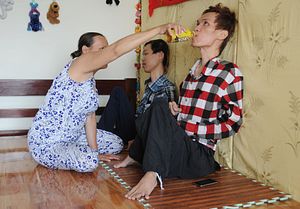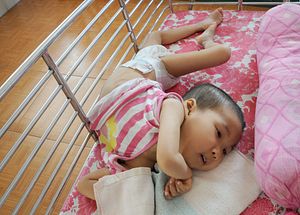DA NANG, Vietnam – The frail bodies of Toan La and his brother sat paralyzed against a wall to prop up their crooked spines, one of many ailments thought to be inherited from their grandfather’s exposure to Agent Orange – a toxic herbicide widely used during the Vietnam War.
Born normal, the Vietnamese brothers grew mysteriously weak as young children and their health has since decayed from a crippling neuromuscular disorder.
Now aged 18 and 22, they are nearly immobile and spend much of their lives stuck inside one room, watching their muscles wither away.
“I am like a baby. I cannot move, take care of myself or do anything that I want,” said Toan, the oldest brother. “I feel that life is so meaningless and I have no more purpose.”
Roughly three million people including 150,000 children born with birth defects have been affected by Agent Orange, according to the Vietnam Red Cross.
As a result, the country’s rate of birth defects has quadrupled after the controversial war.
From 1961 to 1971, the U.S. military sprayed almost 20 million gallons of Agent Orange and similar noxious chemicals over almost a quarter of southern Vietnam to strip foliage and deny communist fighters cover.
Activists claim it was the largest chemical warfare campaign ever conducted.
“The consequences that it left behind are the most severe in the history of mankind,” said Ha Thi Mac, one of the deputy directors for the Vietnam Association of Victims of Agent Orange/Dioxin (VAVA).
Dioxin, a key ingredient in the herbicides, is linked to a myriad of reproductive and development issues as well as other severe health problems in Vietnamese people and U.S. veterans who served in the war.
The deadly substance can have a lifespan of more than 100 years and still pollutes food and water sources, researchers say.
Despite the evidence, the “U.S. government has never accepted responsibility for the damage it caused to the people and the environments in Vietnam,” Mac said.
Lingering Aftermath
While dodging blame for its destruction, the U.S. has agreed to help clean up the Da Nang airport where large stockpiles of Agent Orange were stored during the war.
The move came as both nations looked to tighten relations as part of the U.S. pivot to offset Chinese influence in the region.
In April, the $84 million project slated to finish in 2016 officially began to treat tainted soil around the airport, now a bustling international travel hub.
Plans are also underway to assess the worst polluted site at Bien Hoa airbase near Ho Chi Minh City, which has three times more contaminated soil.
But dozens of other toxic “hotspots” across the country remain untouched and it is not yet known if similar multimillion dollar projects will occur.
The U.S. government also launched a three-year, $9 million project in 2012 to support disabled people regardless of their condition, officials say.
Agent Orange victims are not openly targeted with the funds.
The reason is that “the extent of exposure to dioxin due to Agent Orange among the Vietnamese people and the link between such exposure and particular [health] effects is uncertain,” Spencer Cryder, spokesperson for the U.S. Embassy in Hanoi, said.
Yet the U.S. government recognizes 15 diseases and birth defects used to compensate an estimated 250,000 American vets exposed to Agent Orange. In 2010, the U.S. Congress set aside $13.4 billion to cover these costs.
The Aspen Institute, an international think tank that has studied the ongoing crisis in Vietnam, urged the U.S. to pay the bulk of a proposed $450 million plan over 10 years to clean hotspots, restore ruined ecosystems, and boost services to victims and their families.
Currently only around 200,000 victims receive $20 monthly subsidies by the Vietnamese government, not enough for loved ones to care of them.
Families often have several sick relatives over multiple generations due to the genetic damage caused by dioxin, advocates say.
“It’s a pretty sad situation to see what has happened to entire families because of Agent Orange,” said Mark Conroy, senior advisor for East Meets West, a regional non-profit. “It’s frustrating not being able to get funding to help these victims.”
A casualty of its own economic success, Vietnam has seen foreign donors vanish after it emerged as a lower middle-income country in 2009.
“At the end of the day, it will have to come down to the Vietnamese government paying attention to them because [foreign donors] are not going to do it forever,” said Conroy, whose group once assisted victims up until 2010 when funds dried up.
To take matters into their own hands, Vietnamese victims filed a lawsuit in 2004 to hold chemical companies, mainly Dow Chemical and Monsanto, responsible for producing the dioxin-laced herbicides.
The same federal judge, who earlier ordered the companies to pay a $180 million settlement for affected U.S. vets in 1984, dismissed the case arguing that the U.S. government contractors had immunity. The Supreme Court denied a petition to hear the case in 2009.
‘A Life Imprisonment’
Just south of this central Vietnam city is a small orphanage, home to several deformed children discarded by their parents.
Inside, a toddler with a curved spine that bends grotesquely backward is seen lying next to a sick child with an enlarged head.
Nearby, a mentally challenged boy is tethered to a wall for his safety while another one sits confused in an unpadded metal crib. Behind them, a paralyzed boy with a skeletal frame whimpers as flies crawl over him.
Despite the varying ailments, it is believed that Agent Orange is their common culprit.
Like countless others, these orphans may be trapped in a life of wasting away since Vietnam lacks early intervention for birth defects and physical therapy to recover damaged bodies, advocates say.
“Their living standards are difficult and they are the poorest among the poor in our society,” VAVA’s Mac said of most victims. “Many of them are not capable of being self-reliant.”
For those who are not bedridden, VAVA and other non-profit groups offer education and vocational training from basic hygiene to computer skills that allow victims to be independent and relieve some of the burden on their families.
But programs are underfunded and reach fewer than 10 percent of those in need.
“Funding is not always stable,” Dinh Van Tuyen, vice director of the Friendship Village, a boarding school for 120 affected youth in Hanoi. “There is financial support for Agent Orange victims but it is not enough to improve their lives.”
Children who only suffer from less serious disorders can be helped at the village, he said.
As for the rest including Toan and his brother, the outlook remains bleak if they can ever be liberated from their maladies.
“If this was a death sentence, it would be better,” Toan said. “But this pain still exists and I deal with it on a daily basis.”
“It’s like a life imprisonment.”
Sean Kimmons is a freelance reporter/photographer based in Thailand who has reported on political instability and violence in the Iraq War, the Golden Triangle illicit drug trade and the HIV/AIDS epidemic in Southeast Asia, among many other topics.









































